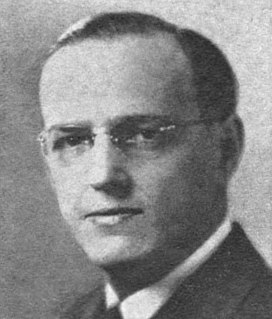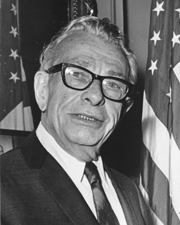
The 1952 United States presidential election was the 42nd quadrennial presidential election. It was held on Tuesday, November 4, 1952. Republican Dwight D. Eisenhower won a landslide victory over Democrat Adlai Stevenson, ending a string of Democratic Party wins that stretched back to 1932.

The 1956 United States presidential election was the 43rd quadrennial presidential election. It was held on Tuesday, November 6, 1956. The popular incumbent President, Republican Dwight D. Eisenhower, successfully ran for re-election. The election was a re-match of 1952, as Eisenhower's opponent in 1956 was Adlai Stevenson, a former Illinois governor whom Eisenhower had defeated four years earlier.

William Fife Knowland was an American politician, newspaper publisher, and Republican Party leader. He was a US Senator representing California from 1945 to 1959. He served as Senate Majority Leader from August 1953 to January 1955 after the death of Robert A. Taft.

The 1952 Republican National Convention was held at the International Amphitheatre in Chicago, Cook County, Illinois from July 7 to 11, 1952, and nominated the popular general and war hero Dwight D. Eisenhower of Kansas, nicknamed "Ike," for president and the anti-communist crusading Senator from California, Richard M. Nixon, for vice president.

The 1968 National Convention of the Republican Party of the United States was held at the Miami Beach Convention Center in Miami Beach, Dade County, Florida, from August 5 to August 8, 1968, to select the party's nominee in the general election. It nominated former Vice President Richard M. Nixon for President and Maryland Governor Spiro T. Agnew for Vice President. It was the fourth time Nixon had been nominated on the Republican ticket as either its vice-presidential or presidential candidate (1960).
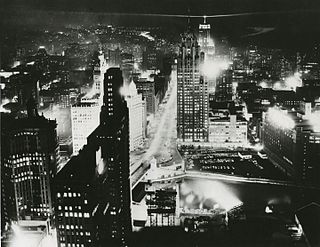
The 1956 Democratic National Convention nominated former Governor Adlai Stevenson of Illinois for President and Senator Estes Kefauver of Tennessee for Vice President. It was held in the International Amphitheatre on the South Side of Chicago, Illinois August 13–August 17, 1956. Unsuccessful candidates for the presidential nomination included Governor W. Averell Harriman of New York, Senator Lyndon B. Johnson of Texas, and Senator Stuart Symington of Missouri.
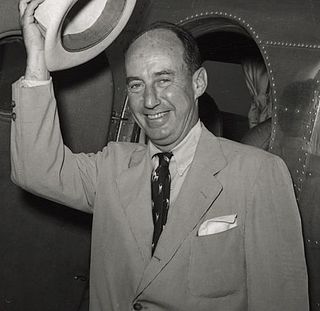
The 1952 Democratic National Convention was held at the International Amphitheatre in Chicago, Illinois from July 21 to July 26, 1952, which was the same arena the Republicans had gathered in a few weeks earlier for their national convention from July 7 to July 11, 1952. Four major candidates sought the nomination: U.S. Senator Estes Kefauver of Tennessee, Governor Adlai E. Stevenson, II, of Illinois, Senator Richard Russell of Georgia and Averell Harriman of New York.
Presidential primaries have been held in the United States since 1912 to nominate the Republican presidential candidate.

The 1952 Republican presidential primaries were the selection process by which voters of the Republican Party chose its nominee for President of the United States in the 1952 U.S. presidential election. Former U.S. Army General Dwight D. Eisenhower was selected as the nominee through a series of primary elections and caucuses culminating in the 1952 Republican National Convention held from July 7 to July 11, 1952, in Chicago, Illinois.
Electoral history of Richard Nixon, 37th President of the United States (1969–1974), 36th Vice President of the United States (1953–1961); United States Senator (1950–1953) and United States Representative (1947–1950) from California.

The 1952 United States elections was held on November 4. The Republicans took control of the presidency and both chambers of Congress for the first time since the Great Depression. The election took place during the Korean War.

The 1952 United States presidential election in New Jersey took place on November 4, 1952. All contemporary 48 states were part of the 1952 United States presidential election. New Jersey voters chose 16 electors to the Electoral College, which selected the president and vice president.

The 1952 United States presidential election in New Hampshire took place on November 4, 1952, as part of the 1952 United States presidential election, which was held throughout all contemporary 48 states. Voters chose 4 representatives, or electors to the Electoral College, who voted for president and vice president.
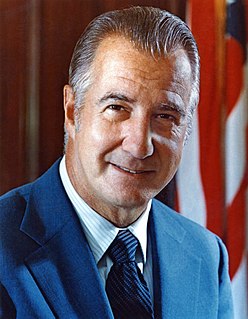
This article lists those who were potential candidates for the Republican nomination for Vice President of the United States in the 1968 election. After winning the Republican presidential nomination at the 1968 Republican National Convention, former Vice President Richard Nixon convened a series of meetings with close advisers and party leaders such as Strom Thurmond in order to choose his running mate. Nixon ultimately asked the convention to nominate Maryland Governor Spiro Agnew as his running mate. By a large margin, Agnew won the vice presidential nomination on the first ballot over Michigan Governor George W. Romney, who was supported by a faction of liberal Republicans. Nixon chose Agnew because he wanted a centrist who was broadly acceptable to the party, had experience with domestic issues, and appealed to Southern voters. The Nixon-Agnew ticket defeated the Humphrey-Muskie ticket, and also won re-election in 1972, defeating the McGovern-Shriver ticket. However, Agnew was forced to resign as Vice President in 1973 due to a controversy regarding his personal taxes.
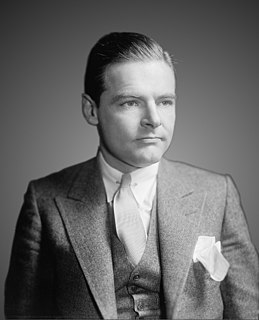
This article lists those who were potential candidates for the Republican nomination for Vice President of the United States in the 1960 election. After winning the Republican presidential nomination at the 1960 Republican National Convention, Vice President Richard Nixon needed to choose a running mate. President Dwight D. Eisenhower strongly supported UN Ambassador Henry Cabot Lodge Jr.. Though Lodge lacked charisma as a campaigner, his foreign policy experience and stature as ambassador made him an appealing candidate. However, Lodge was unpopular with the Republican right, who did not want a Northeastern moderate on the ticket. Nixon also strongly considered conservative Minnesota Representative Walter Judd and moderate Kentucky Senator Thruston Morton. After a closed session with Republican Party leaders, Nixon announced his choice of Lodge. The Republican convention ratified Nixon's choice of Lodge. The Nixon-Lodge ticket lost the 1960 election to the Democratic ticket of John F. Kennedy and Lyndon B. Johnson.
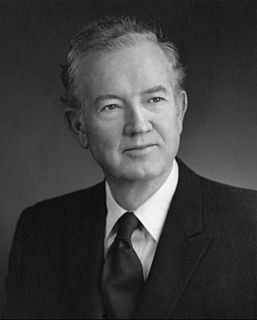
This article lists those who were potential candidates for the Democratic nomination for Vice President of the United States in the 1952 election. After winning the presidential nomination on the third ballot of the 1952 Democratic National Convention, Illinois Governor Adlai Stevenson consulted with Democratic Party leaders such as President Harry S. Truman and Speaker Sam Rayburn. Stevenson chose Alabama Senator John Sparkman, a Southern centrist, as his running mate. Sparkman won the vice presidential nomination on the first ballot as no serious rival tried to displace Stevenson's choice. However, many Northerners were not enthused with the choice of Sparkman due to Sparkman's stance on civil rights. During the 1952 convention, Sparkman, who had supported Senator Richard Russell for president, played a part in watering down the party's platform on civil rights. New York Representative Adam Clayton Powell Jr. and others walked out of the convention after the choice of Sparkman was announced. The Democratic ticket lost the 1952 election to the Republican ticket of Dwight D. Eisenhower and Richard Nixon.

This article lists those who were potential candidates for the Republican nomination for Vice President of the United States in the 1944 election. At the start of the 1944 Republican National Convention, New York Governor Thomas Dewey seemed like the likely presidential nominee, but his nomination was not assured due to strong support for Ohio Governor John W. Bricker and former Minnesota Governor Harold Stassen. Though Dewey wanted California Governor Earl Warren as his running mate, Warren was convinced that Franklin D. Roosevelt would win re-election, and refused to be anyone's running mate. Some Republicans wanted to ask Democratic Senator Harry Byrd of Virginia to be the Republican running mate in order to pursue the Southern vote, but this possibility was not seriously pursued. Dewey and his advisers instead worked out a deal in which Bricker's delegates voted for Dewey in the presidential ballot, and Dewey in return chose Bricker as his running mate. The Dewey-Bricker ticket, which balanced the moderate Northeastern and conservative Midwestern wings of the party, was ratified by the Republican convention. The ticket lost the 1944 presidential election to the ticket of Franklin D. Roosevelt and Harry S. Truman.

The 1952 United States presidential election in Connecticut took place on November 4, 1952, as part of the 1952 United States presidential election which was held throughout all contemporary 48 states. Voters chose eight representatives, or electors to the Electoral College, who voted for president and vice president.

The 1952 United States presidential election in Maine took place on November 4, 1952, as part of the 1952 United States presidential election which was held throughout all contemporary 48 states. Voters chose five representatives, or electors to the Electoral College, who voted for president and vice president.

The 1952 United States presidential election in Rhode Island took place on November 4, 1952, as part of the 1952 United States presidential election which was held throughout all contemporary 48 states. Voters chose four representatives, or electors to the Electoral College, who voted for president and vice president.




